
Buying as One: Category Management Lessons From the United Kingdom

A purchasing strategy adopted by the private sector three decades ago, called category management, organizes the spending on common goods and services across the enterprise into defined categories, such as travel or commercial software, from the same or similar supplier base.
The United Kingdom began its category management initiative in 2010 and its greater maturity offers some useful lessons to the U.S. government’s more recent efforts on how to increase the adoption rate and avoid potential missteps. By “buying as one,” the Office of Management and Budget projects that the federal government can avoid up to $18 billion in unnecessary spending by 2020, but commercial experience and the experience of the United Kingdom suggests it could be significantly more.
The report contains insights based on the U.K. government’s implementation efforts and offers recommendations to the U.S. and other governments that may help accelerate or expand their efforts.
Read the article in GovernmentExecutive on the report.
View our infographic on the report.



